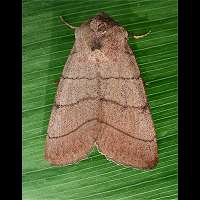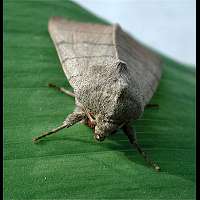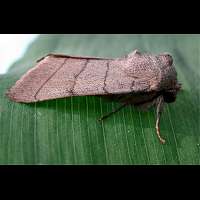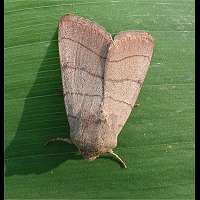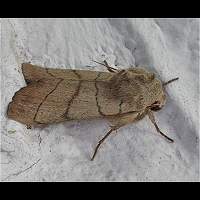Treble Lines Charanyca trigrammica
Why this species was ever called Treble Lines probably remains a mystery forever. If you look carefully you will see four similar lines and not three. The fourth line is near the very top of the wing, but once you have seen it: it is there! Yet, even the Dutch call it the Treble Line Owlet, so we will give in here. In it's usual and typical form, like the one seen on this page, this species is unmistakable. There is a second form though, which is more difficult to identify at times. It is darker and the middle of the three lines has become very large or even developed into a vague dark smear. This way there appears to be a dark area between the first and the third line. Animals looking like that are similar to Double Line. However they lack the white spot in the wing so characteristic of the Double Line. The wingspan is some 33 to 40mm.
The caterpillar of the Treble Lines is quite long lived. It will hatch in June usually and stays close to the ground all his life. During the night low growing leaves are eaten, during the day it hides in the ground, just below the surface. It overwinters being an almost full grown larva, remaining active in mild winter nights. By the end of March or the beginning of April the caterpillar stays underground to pupate. Sometimes pupation takes less than a month. The foodplants are all low growing plants, such as Dandelion, Knotgrass and Common Knapweed. The caterpillar is of a variable kind of brown. There is a rather small light dorsal line with dark borders. The spiraculae are very dark and rather big. The head is brown. The caterpillars of Treble Lines grow to some 30 to 35mm.
This species is on the wing from mid-May to early July. Treble Lines flies by night only, but is regularly seen visiting flowers, including those in parks and gardens. During the day it hides in low growing vegetation, such as grass. Easily photographed and may be handled doing so. Is attracted to both light and sugar, usually not in great numbers though. It inhabits open woodlands, edges of woods, hedges and other places like that all over England, Ireland and Wales. Treble Lines is getting scarcer northwards though and is not reported from Scotland. A common species in most other parts of Europe too, except for Northern Europe.
Why this species was ever called Treble Lines probably remains a mystery forever. If you look carefully you will see four similar lines and not three. The fourth line is near the very top of the wing, but once you have seen it: it is there! Yet, even the Dutch call it the Treble Line Owlet, so we will give in here. In it's usual and typical form, like the one seen on this page, this species is unmistakable. There is a second form though, which is more difficult to identify at times. It is darker and the middle of the three lines has become very large or even developed into a vague dark smear. This way there appears to be a dark area between the first and the third line. Animals looking like that are similar to Double Line. However they lack the white spot in the wing so characteristic of the Double Line. The wingspan is some 33 to 40mm.
The caterpillar of the Treble Lines is quite long lived. It will hatch in June usually and stays close to the ground all his life. During the night low growing leaves are eaten, during the day it hides in the ground, just below the surface. It overwinters being an almost full grown larva, remaining active in mild winter nights. By the end of March or the beginning of April the caterpillar stays underground to pupate. Sometimes pupation takes less than a month. The foodplants are all low growing plants, such as Dandelion, Knotgrass and Common Knapweed. The caterpillar is of a variable kind of brown. There is a rather small light dorsal line with dark borders. The spiraculae are very dark and rather big. The head is brown. The caterpillars of Treble Lines grow to some 30 to 35mm.
This species is on the wing from mid-May to early July. Treble Lines flies by night only, but is regularly seen visiting flowers, including those in parks and gardens. During the day it hides in low growing vegetation, such as grass. Easily photographed and may be handled doing so. Is attracted to both light and sugar, usually not in great numbers though. It inhabits open woodlands, edges of woods, hedges and other places like that all over England, Ireland and Wales. Treble Lines is getting scarcer northwards though and is not reported from Scotland. A common species in most other parts of Europe too, except for Northern Europe.

